|
|
[PERBINCANGAN] Belajar Apa Sahaja Berkaitan Jepun
[Copy link]
|
|
|
Well, they say a picture is worth a thousand words, so why not show you some of Japan through some eye-opening digital photographs? Some may delight, some may amuse, and some may shock you. But I'd thought I'd share some interesting displays that are special in Japan.

1. The Public Phones   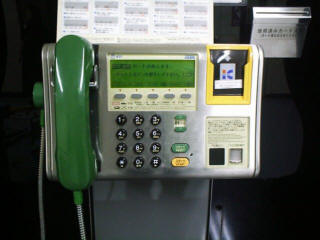
One of a countries most distinctive features is in its pay phones. They're not seen in any other nation the same way, and since if you come here you'll almost certainly be using them, here they are! Note that there are 2 of them--the neon-green is the older type and the drab gray one the newer type. Both are still found all over Japan, but eventually the green ones will disappear.
So how are they different? Well, the biggest differences are that the green phones are for domestic calls only (unless you sign up with a company that hooks up your calls internationally). Some of the gray phones are only for domestic calls like the green one, but others allow direct international calls also. (You'd be an idiot to use the Japanese international telecoms though, with their outrageous prices and constant telemarketing harassment -- sign up with a callback company or use a prepaid card service!!) See the gold bars around the gray phone's LED display? That shows you it's able to place international calls also.
Both phones let you pay by either using 10 yen, 100 yen, or a thin magnetic telephone card. Nearly any convenience store, kiosk, and many phone booths have vending machines for phone cards. There is a 500 yen type (50 ten-yen units) or a 1000 yen type with 105 ten-yen units. They are not refundable, and phones do not give change for unused portions of 100 yen coins. If you do place an international call, you can use only 100 yen coins or the cards. Since certain youths who're fed up with Japanese prices for international calls found a way to recycle spent cards, the gray phones on city streets have been changed to only accept 100 yen coins for such calls. Another difference is that the gray phones have both an analog and digital phone jack you can connect a laptop or palmtop to for sending data, a fax etc. There are also a few variations of the green phone, and older bulkier type as well as a smaller, phone-card only type.
The 3rd phone there is just beginning to appear around the country and uses a new phone card, theIC card. This is not compatible with the other phones. Eventually these will replace the others, andtheir cards use an IC that slowly burns itself out. You can insert up to 2cards into the phone and the card with less remaining units will be used first.
If you look around enough, you might just find the REALLY old rotary dial types as well.
Oneother difference nobody tells you about -- the gray phones may not workwell if you're calling your own answering machine to see if you haveany messages. For many phones, the machine answers one ring later ifthere are no messages, to save you from wasting money to find out ifsomeoneleft you a message or not. But with the gray phones there is somedelay, so when you hear the 3rd ring it's really the 4th, with thephone machine answering and then telling you there are no messages. Ifthis happens to you, try sticking with the green phones.
2. The Japanese Postbox 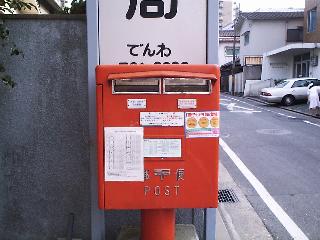 Here's another special part of Japan--like their phones, their mailboxes are quite distinct. Originally they were modelled after those in Great Britain. The one in this photo is typical of those used today though. The blue slot on the left is for regular domestic mail; all other mail goes in the right red slot. Delivery times are posted on the side. Note also the open sewers on the right--during the summer they will take your breath away. Here's another special part of Japan--like their phones, their mailboxes are quite distinct. Originally they were modelled after those in Great Britain. The one in this photo is typical of those used today though. The blue slot on the left is for regular domestic mail; all other mail goes in the right red slot. Delivery times are posted on the side. Note also the open sewers on the right--during the summer they will take your breath away.
3. The Dominos Pizza Delivery Scooter  Here's something you don't exactly see running around your neighborhood. Want a pizza for dinner or that ball game on tonight? You'll find many pizza delivery services, as well as more Japanese versions of ramen, okonomiyaki (a fried Japanese pizza), etc. Since Japanese streets are routinely a moving parking lot, you'll almost certainly see them deliver your food in these cheaper, (lower-taxed) mobile 50cc engine bikes. If you move into an apartment or house it won't be long before you see some menus pop up in your mailbox. Unlike in the U.S., there is no tipping of the delivery boys, waitresses, maids, etc. And after seeing their prices, you won't feel much like it, anyway. Here's something you don't exactly see running around your neighborhood. Want a pizza for dinner or that ball game on tonight? You'll find many pizza delivery services, as well as more Japanese versions of ramen, okonomiyaki (a fried Japanese pizza), etc. Since Japanese streets are routinely a moving parking lot, you'll almost certainly see them deliver your food in these cheaper, (lower-taxed) mobile 50cc engine bikes. If you move into an apartment or house it won't be long before you see some menus pop up in your mailbox. Unlike in the U.S., there is no tipping of the delivery boys, waitresses, maids, etc. And after seeing their prices, you won't feel much like it, anyway.
4. The Ubiquitous Vending Machine
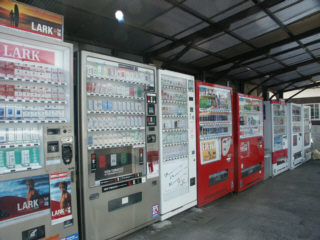  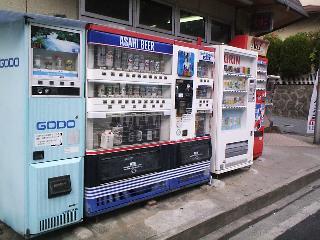
Vending machines for everything.....In Japan the 24 hour convenience store is still relatively new--but even if you're in the boondocks you won't need to worry. You'll find vending machines like these here selling everything. And I do mean everything. Liquor, cancer sticks, rice, condoms, girlie magazines, comics, etc. etc. The Asahi machine seen here not only sells regular cans, but 633ml and 2 liter bottles also. The vending machines for soft drinks not only sell cold drinks but hot canned coffee in the winter as well.
5. Next Stop......The Gas Chamber  
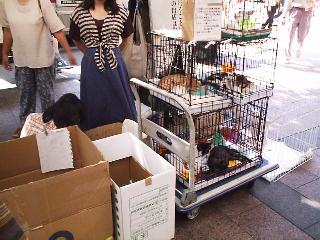
If you're one of those who's been lulled into thinking Japan is one big La-La Land, maybe these will wake you up. Here, extremely few people bother to spay their pets. The result? You guessed it--the killing of thousands of animals each year because the owners either kick the new offspring into the street or give them to the city to be destroyed. And worst of all, it is a slaughter that is COMPLETELY UNNECESSARY. Everyone marvels at the "Tamagochi", or the robot dog just invented, but few ever understand WHY they are popular in the first place. For most people, owning a pet is virtually a luxury--and if you live in a condo or apartment you probably aren't even allowed anything besides a plant or a goldfish. In these photos, you can see a few cats who have nowhere to go except the streets; in the other you can see some women who deserve some award but won't get any. But there they are, on a busy street every day, trying to give away any impounded pet they can before its time is up. For nearly all of these unwanted pets, it's really a Death Row. The moral of the story is, if you have a pet, NEUTER IT ALREADY!!
6. If You Can Rent A Video, Why Not A CD?!?
Here's something else you can do in Japan that you can't in other countries. Why does this industry thrive? Well, in part because Japanese radio and TV broadcasts are so dismal. Rarely is a song played in its entirety -- instead you have blabbering, chattering DJs who like to hear the sound of their own voices. Prices for renting CDs are not too different from a video. Until a few years ago, you could rent a new CD just as it was released, just like videos. But then came the greedy, whining US record companies who stammered and hollared about lost profits (we all gotta help those record execs buy their 3rd Mercedes). So the Japanese gave in partially and made a new law that would keep new CDs out of the rental shops until they were at least a year old. For videos, nearly all big name videos from the US and Europe are here in Japan, but sorely delayed. In most cases, if it's coming out on video in the US then it's just starting its theatrical run in Japan--so if you're coming to stay a while in Japan, see everything you want to before you come. |
|
|
|
|
|
|
|
|
|
|
|
7. There's No Place Like Home! 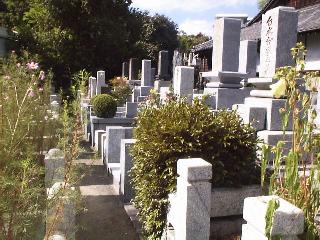 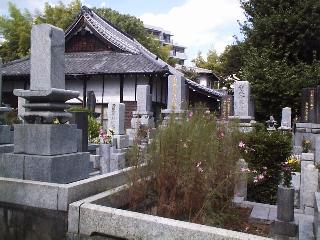
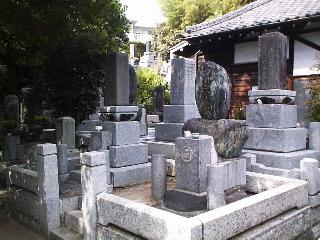
This is something the guided tours and Japan National Tourist Organization leave out of their recommended places to visit, but you can see a lot about Japan by looking at its cemetaries.Because of the price of land, partial cremation is the norm. It's a far cry from the endless green hills and quiet lawns of those in the US--here you'll find people's homes right next door. What they think of that is hard to tell; at least the people have quiet neighbors....
7. "The Facilities" 
If none of these pics have provoked a response from you, this one surely will. Your first question will probably be, "How the hell does this thing work?!?". What, you've never gone camping before? Think of it as a hole in the ground that flushes, and you'll get the idea. As far as "Culture Shock" goes, this one might hit you right at home, so to speak. If you live in Japan, sooner or later you'll have to deal with one of these. And when you go looking for a place to live, most older buildings (where the rent is cheaper) will have Japanese style toilets. If you just can't deal with this though, many new apartment houses are equipped with the western-style, and if you're out on the town, most of the newer department stores as well as the ritzy tourist hotels have at least one western style facility.
8. The Gulag?  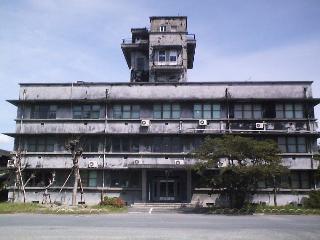
What's this? A Stalinesque Japanese prison? A bombed out remnant from the war for world peace? Nope--it's a Japanese public university--and it's very much in use. You might be surprised at the grungy, drab, delapitated-looking buildings they actually use for classrooms at public schools. All they'd need is a few (dozen) coats of paint to look a lot better. But spending for such things in Japan is always at the backburner--yet giving massive chunks of pork to bloated construction companies or subsidies to inefficent farmers never goes away (and guess who has the political clout). In stark contrast, buildings at private universities look a whole lot better. You'd think with all the earthquakes in Japan these public school buildings would have come down long ago. But there's always hope for the next big shaker.......
9. The Love Hotel 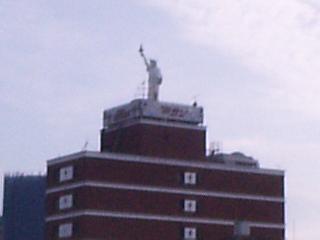 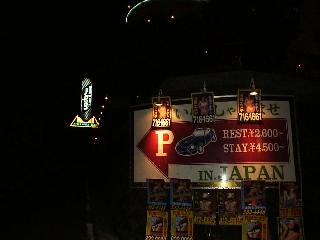
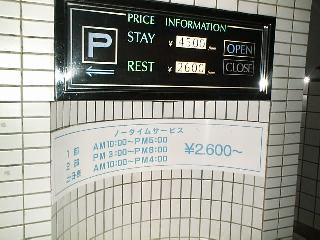
When you come to Japan, you won't be able to help but notice certain hotels decked out in glittery neon and flashing lights. What are these places, anyway?? Welcome to the Love Hotel. That's what the Japanese call them, anyway (rabu hoteru), and "rabu" is a common euphemism for sex. Here you can choose a room with various themes, and rent the room for a few hours or for a full night. In the photo above the Japanese have taken the Statue of Liberty and turned it into a Statue of License. What about the so-called "family values" crowd harping about morality? Hey, the mindset here is if you're old enough to pay, you're old enough to play.
But you should look on these as more than just a curiousity--if you're looking for a place to stay, you might just consider staying in one (even if you're alone). They're far cheaper than other hotels, they're easy to find, and staying in one is an experience, to say the least. In most cases, you'll find clusters of them wherever young people congregate or at major highway exits. In the 3rd picture above, you'll find three pay scales. The top is the full night rate, the middle price is for a "Rest" (Read: 1-2 hours of lust and passion), and the bottom, called "No Time Service" is for off-hours, usually weekday afternoons. It may be tough to find an open room on weekend nights. Prices in Tokyo are around US$30 for the "rest", and US$80 a night--but may be higher for fancier hotels and cheaper for suburbs, highway exits and secluded areas. One caveat--once you go in, you can't leave until you pay--and then you can't come back in unless you want to pay all over again. Food and drinks are also in the rooms, but very expensive--if you choose this option, bring some food or drinks with you before you go in.
10. Neon City 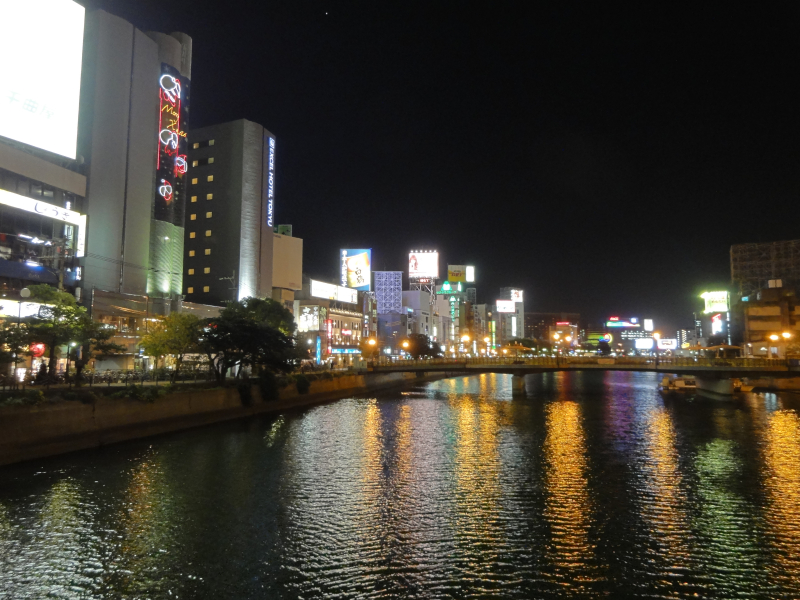
One of the first things that will certainly strike you if you come to Japan is the glittery, neon lights of the big cities. You'll immedeately feel yourself swallowed up by lots of lights, moving and dancing signs, many of which have become near icons of the cities they're in. Other Asian cities have the same atmosphere, but actually being able to read all the signs is one thing special to Japan. The photo here is of the red light district called Nakasu, in Fukuoka City. It is puny compared to that of Shinjuku and Shibuya in Tokyo, or Dotonbori in Osaka. But it has a charm unique to itself, and this still pic can't come close to grasping the real atmosphere of the area. You'll find all the sparkles you could ever want, and the cheesey, sex-for-sale elements too side by side. Many of the customers here are middle-aged businessmen, entertaining customers on the company credit line. But with the economic slump in Japan, this is one area that's taking a beating.
11. Blatant Lies
"Beggars are not unusual in the wealthy socities of Europe and North America--many American cities, like New York, even run shelter systems--but in Japan there are no beggars. They do not exist." --- EPA bureaucrat Taichi Sakaiwa, in his book _What is Japan?_, 1993, pp.6
"There is essentially no poverty in Japan." --- Eamonn Fingleton, Japan Revisionist extraodinaire, in his book _Blindside: Why Japan Is Still On Track to Overtake the U.S. by the Year 2000_, 1995, pp.65 (Well, the clock is ticking down fast...)
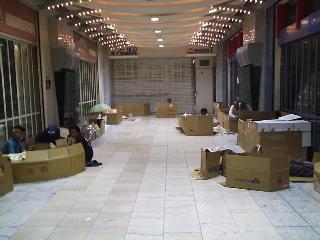 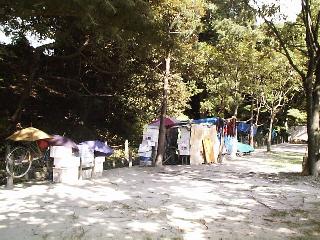
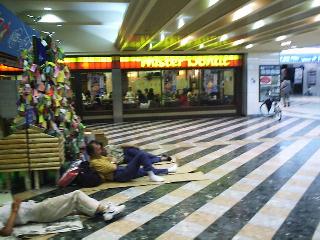 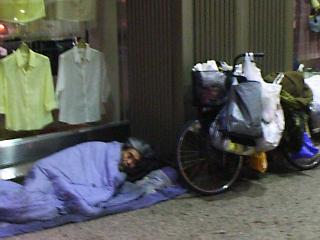
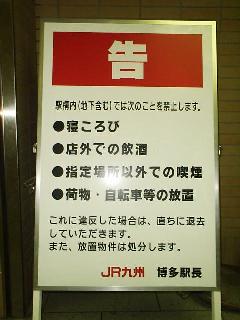
Photos: Upper Left--Another cardboard city springs up in "poverty-free" Japan.I guess only one is really homeless and the other 999 are all anthropology field researchers...Upper Right--A long vacation in a city park. Mid-Left--Lots of happy campers in frontof a Mr. Donut, while the customers enjoy the view. Mid-Right--An eager customerwaits for the ladies apparel shop to open in the morning. Lower-Left--A sign (completely ignored)forbidding sleeping, drinking, smoking, or leaving your stuff or bikes around. Violators face arrest and their things being trashed. Of course, when you have nothing,you have nothing to lose either... While it may be said that there are far fewer homeless and beggars in Japan, they DO in fact exist, and with Japan's comatose economy the numbers are growing annually. Just look in any urban train station at night. That said, at least in Japan there are no pushy, in-your-face pan-handlers who think you OWE them your spare change. Still, to have such nonsense pushed onto the West and then carried by the die-hard Japan groupies who take any slighty negative comment on Japan to mean you're a "racist", a "basher", a whining malcontent etc. is the biggest lie of all. As said, Japan's quasi-socialist system of employment keeps an unemployment rate lower than most advanced western countries (with consumers paying for it, of course), but this underclass does exist and once you fall in it's almost impossible to climb your way out. With the tradition of the multi-generation family in one home eroding, record bankruptciesand business related suicides, as well as industrial restructuring requiring the sacking of the corporate deadwood (madogiwazoku) and the absence of any effective welfare system, this is a growing problem Japan is going to have to deal with. (BBC RealAudio Report Here) The flipside of westernization........ |
|
|
|
|
|
|
|
|
|
|
|
12. Beyond Description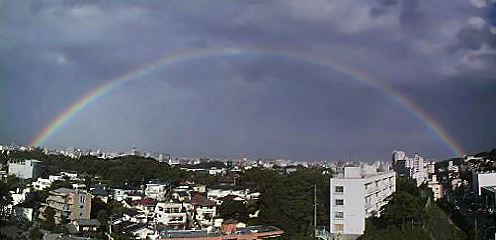
I've only seen this once in over 10 years here, but I really want to share these with you. Not much I can say about such a gift from God, except thanks for being healthy and being able to witness such beauty.
13. Do You Feel Lucky?........Well, DO YA, PUNK?!? 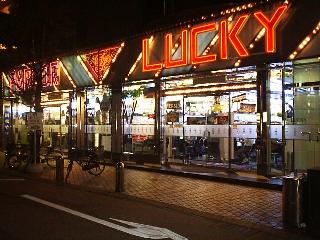 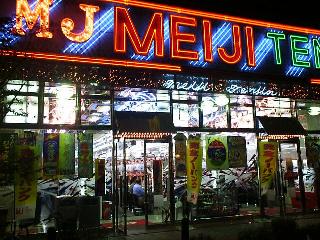
 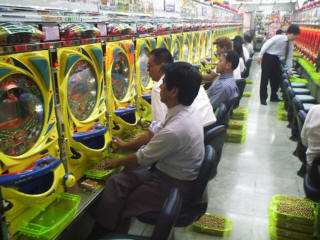
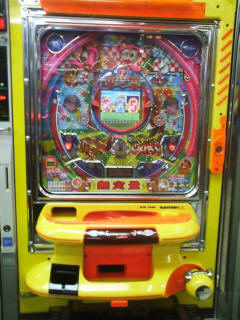
Click here for Quicktime Video
Walking past one of these pachinko parlors, you can't help but feel like you're inside the pachinko machine. Pachinko isn't pinball exactly, it's putting balls in holes, getting more balls, and hopefully winning enough to get some money at the end, i.e. gambling. Pachinko is also one of the "three pillars" of Japanese life -- drinking, smoking, and gambling -- and usually 2 of them are being done simultaneously. Don't be surprised if you see clouds of smoke pouring out of the place and you can't see the machine in front of you.... So can you win? You bet -- skill is a big part of the game. And the swirling, sparkling lights and animation of the building as well as on the machines themselves are a special, unique sight of Japan. You couldn't avoid these places if you tried, so by all means go in one and look around!
14. Hanabi--Flower Fire 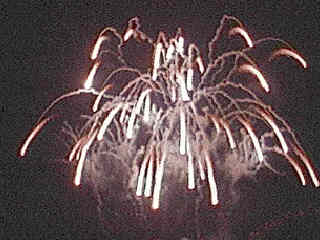 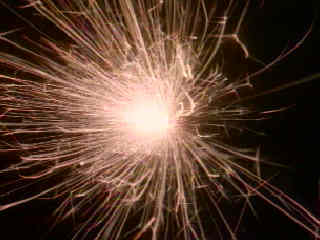
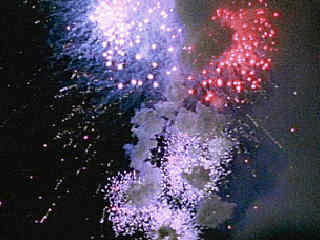
Nobody seems to know WHY people in Japan always do fireworks in the summertime, and who cares anyway? Here are a few pics of some nice explosions over out heads....there are usually several fireworks festivals in populated areas during the summer, and it's one of the few times you can see some Japanese girls wear their cute yukata, which are light summer kimono. Many fireworks festivals are close to the O-Bon Festival, which is the Japanese festival of the Dead (it's anything but somber though). Expect to see crowds as dense as a Tokyo morning train at these fireworks events!! You can also buy small fireworks in stores during the summer (and only the summer--buy some for New Year's if you're not going anywhere for the holidays).
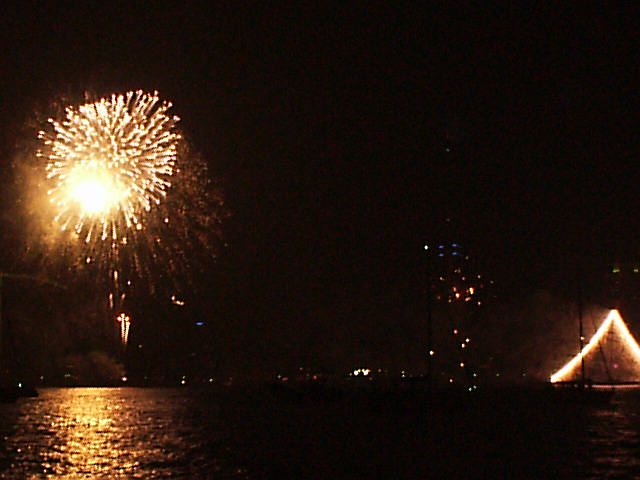
15. Homesick?  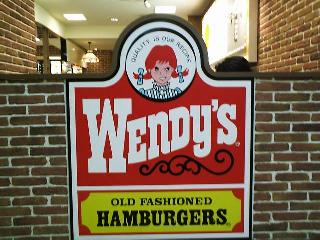
 
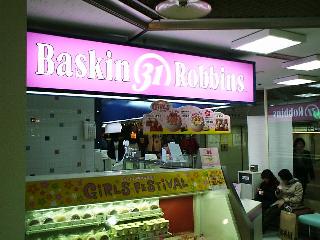 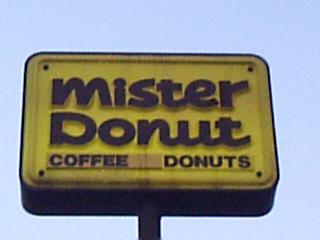
 
Despite the higher costs of living in the big city, there is one advantage over being in some tiny village in the mountains--a few restaurants to chase the homesick blues away. Here are some pics of a few of them; there are far more in Tokyo and Osaka, including Dennys, Tony Roma's, Shakey's, TGIF, and some others. What Japan really lacks though are Taco Bells, a complaint heard far and wide among long-term ex-pats going through taco withdrawl. These eateries are no cure though--when the check arrives and you find it costs 2 to 4 times the price back home, you might feel a bit relunctant to make going there a weekly habit.
The Kogyaru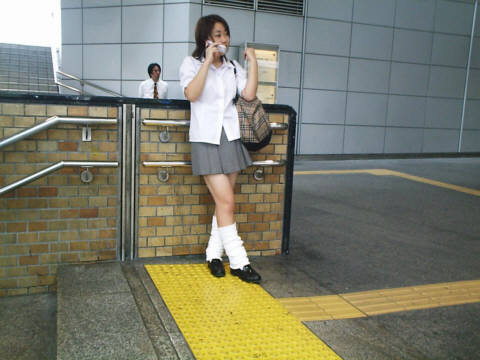
The kogyaru, or little girl look, is truly one of the most famous images in Japan, and thisphoto illustrates the most famous attributes -- the cell phone and the "loose socks". Somein Tokyo are more extreme with darkened faces and white make-up.These girls are the trendsetters of the nation, as well as perhaps the future saviorsof the economy with Japan's declining birthrate and fewer people to fill those career roles traditionally reserved for men only. The kogyaru image is also revered amongmiddle-aged men watching the remainder of their youthful looks slip away, plusfeeling unfufilled in life after cramming all day long for university entrance exams in their school days and then slaving away for years in a company after that.
For these girls today having the newest and cutest phones is the in thing, andwith stiffling school rules dictating every aspect of their school lives, the bizarrelooking socks are still trendy after several years, perhaps because it is about as faras the girls can go in school to be more individual yet not break the regulations. There is oftensuch a friction between Japan's conformity-or-else rules and young people longingfor a breath of fresh air.
16. Safe Sex Japan Style
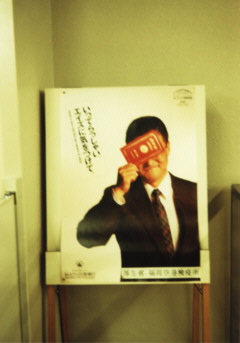
"Bon Voyage - Watch Out For Aids"
This message of love from the Japanese Ministry of Health & Welfare was in frontof the airport departure gates. It's aimed squarely at Japanese businessmen goingabroad. Meanwhile, the same Japanese government only recently relented after 30 yearsof obstructionism in preventing the sale of the Pill for birth control. The reason forthe ban? To help prevent Japanese promiscuity and the spread of AIDS. |
|
|
|
|
|
|
|
|
|
|
|
The Japanese Car Wash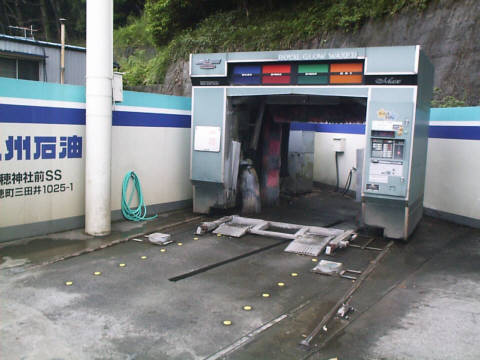
With every square foot of land at a premium, having an American style car wash isjust not worth it. Hence you have the Japanese version, where the car wash movesand the car is stationary.
If You Ever Needed Tissues...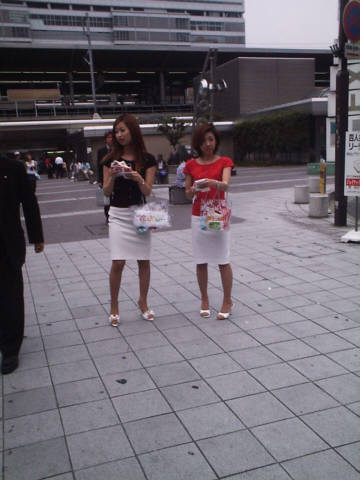 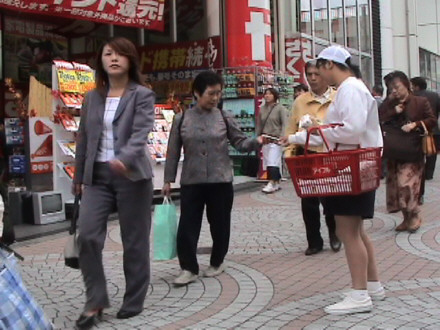
At the larger train stations and shopping squares, you will often find young peoplepassing out freebies to all passers-by, usually small packets of tissues with anad in them, but also product samples and new goods that just hit the store shelves.Especially in the summertime with the crushing humidity, having some tissues inyour pocket to wipe your brow is indeed a welcome thing.Little items and ads for bars in the red light district are also passed around nowadays, and these 2 ladies in the photo are most likely here for that.
While it was normal 10 years ago to pass out everything to everyone, with the economy ina coma now some people won't bother offering tissues to foreigners.
Click here for Quicktime Video
The Convenient Convenience Store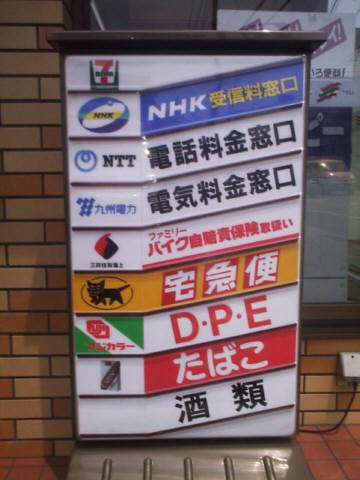
While you won't find the bargain priced huge fountain drinks like in Canada and the U.S.,many convenience stores in Japan do offer some very nice services, as shown in theseboards outside each store. In this board, the store shows you can pay bills for owning atelevision (which many people ignore), phone bills from NTT, electric bills, and motor bikeinsurance. You can also send parcels to people through private companies calledtakyubin, as well as D.P.E. which means developing your camera film. The bottom twoshow they sell liquor and cigarettes as well. The services at convenience stores, or konbini, as they're called, can vary wildly, however. It takes miles of red tape to get anything done inJapan, but the bureaucracy to get a liquor license is truly monumental. Many of the stores that sell liquor bought out some previous mom-and-pop liquor store who cashed in theirchips. Some stores are also putting in ATMs, but unlike the Japanese post offices theirmachines are for cards in Japanese credit systems only. If you live in the sticks though with long distances between everything, stores like this can be a godsend. |
|
|
|
|
|
|
|
|
|
|
|
Taking the Ol' Bus 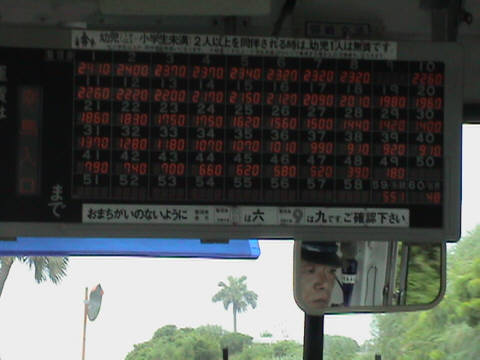
In Japan, the distance you ride determines how much you will pay. When you board thebus, you take a ticket with a number on it. As the bus rolls you can look at a board bythe driver and see what your fare will be. You then drop the fare in the machine by the driver.You can also easily get change for 1000 yen bills, 500 and 100 yen coins from the same machine.
Plastic Food - A Picture is Worth A Thousand Tastes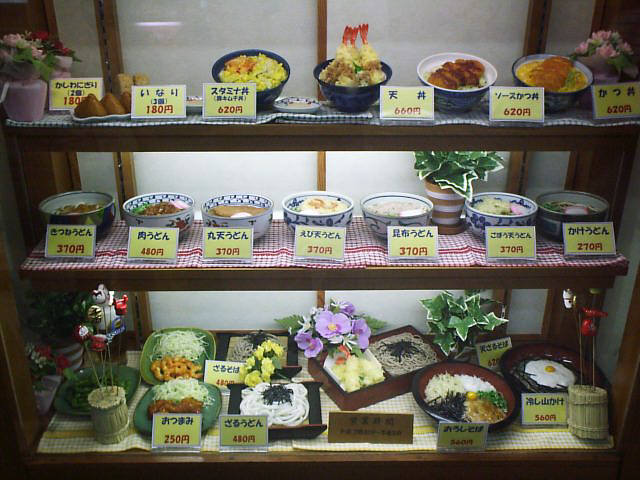
One important factor about Japanese food is not only its taste, but its artistic preparation aswell. And extending from that are these plastic replicas of Japanese dishes at the front of the restaurant to show how delicious they'll be. Even glasses of beer with foam look so real you have to squint at the detail to tell them apart from the real deal. Not all restaurants show these, but many do and they offer you one useful feature -- if you can't read the menu, just take the waitress outside and point at what you want.
The Police Box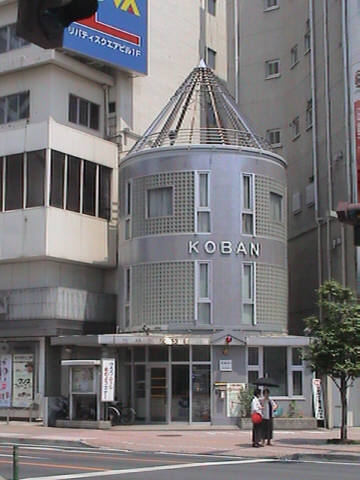
The small police box, or koban, is one more element that stands out in Japan.If you ever need a cop, you might find a couple walk or bicycle over to you from oneof these neighborhood stations instead of waiting for 45 minutes for a cop to driveover from downtown. The one in the photo prominantly displays what it is but manykoban are little more than a drab old shack with a red light at the entrance.
Happiness Is a Well Regulated Society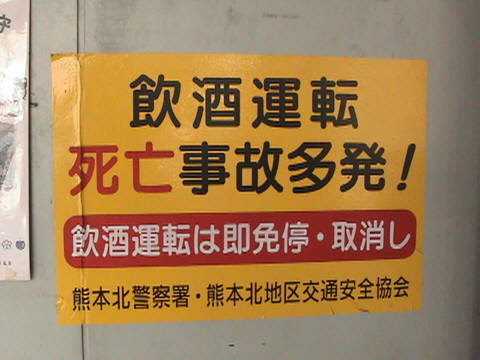 
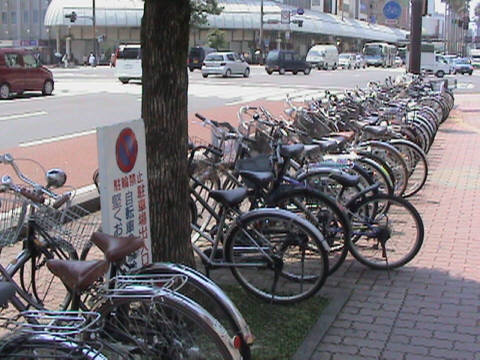 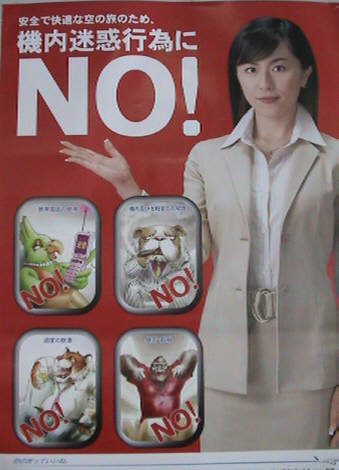
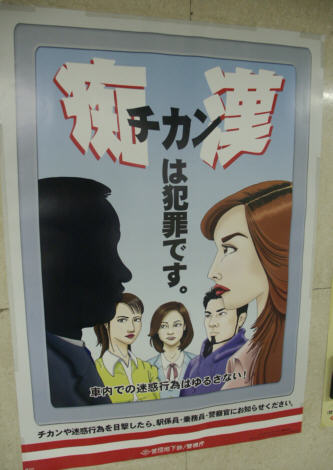 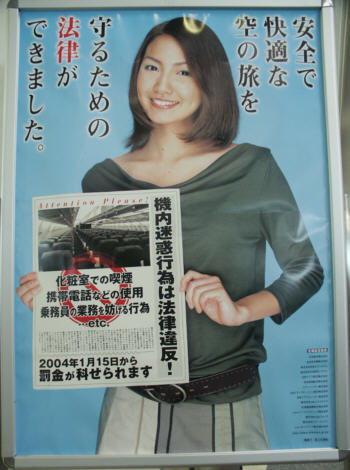
All across the country on telephone poles, train station walls, buses, and school bulletin boards,you can catch a glimpse of some of the underside of a society. Unreadable by the tourists walking past though, there they are, each with a story the fluffy tourist guides avoid.
Upper left: Under the Influence - A warning about drunk driving, as thatarea is well known for several drunk driving accidents.
Upper right: Claiming Your Territory - A warning to curbyour dog....unfortunately, it's quite easy to see why there are a lot of signs like this.
Mid-left: Gotta Park Somewhere - A sign by a train station not to park your bicycle there. But since the cops don't feel like doing anything to a locked bike, it's almost always ignored.
Mid-right: Wild, Wild Life - A warning about boarding a plane and 1) using a cell phone, 2) smoking, 3) getting drunk, and 4) raising hell while on board.
Lower Left: Chikan - The Subway Groper - Every schoolgirl and woman in Japan knows about the groperin crowded trains, ready to stick his hand up a skirt when trains and subways are packed. Many womenpassively take it instead of raise a noise and be embarassed in front of everyone. The poster shows it'sillegal, but it's still a daily occurrence in the land of crime-free harmony.
Lower right: Happy Fines For Happy People With Happy Problems - This cheerful sign is for all the chain-smoking drug addicts on airplanes who try to sneak a cancer stick in the lavatory, neurotics glued to their cell phones, as well as anyone obstructing the crew. From Jan. 15, 2004 you now get astiff fine.
The Discount Store JingleAnother facet of Japan is that there are all kinds of discount stores, and each seems to have its ownlittle jingle going off in the store, played ad nauseum all day long. Some are more quaint and others willjust make you queasy. Below are a few samples, the first is perhaps the most musical for a store, Don-Quijote,which sells various goods including liquor at suprisingly refreshing prices, but their song sounds more like "Donkey Hotei". There is also an English version that is nearly unintelligible.Another example is for a discount electronics seller, Bic-Camera, a great place to go shopping, by the way. Andif there ever is a Fingernails-on-the-Chalkboard Award, it would have to go to the third example, Yamada Denki.Imagine working there with this song repeated every 2 minutes....after about 2 weeks you'd seriouslywant to go out and hurt someone. After 3 weeks, you'd probably want to go out and hurt yourself....
The Don-Quijote Song The Bic-Camera Song The Bic-Camera Song The Yamada Denki Song The Yamada Denki Song
The Mama-Chari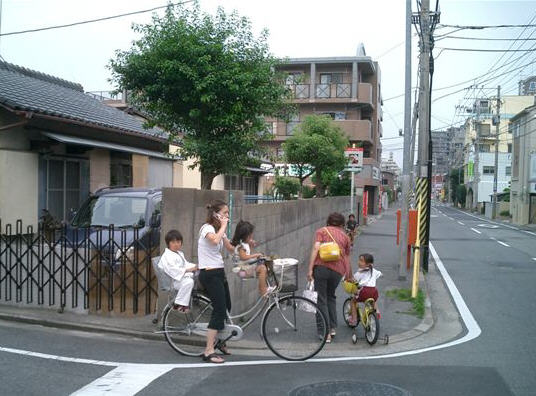
One thing that you can see all over Japan is the mother taking the kids to school orback home -- not many soccer moms driving gas-chugging SUV's here. Parking is often tougheven in the suburbs and gas prices compared to the US or Canada will make your eyes fall out.The term "mama-chari" comes from mama for mother, and "chari", a contraction of "charinko", whichis Japanese slang for bicycle (jitensha). Technically it may be illegal to carry your kids around this way, but it is still a common sight and a way to get around and burn some calories as well.
Your Future's In Your Hands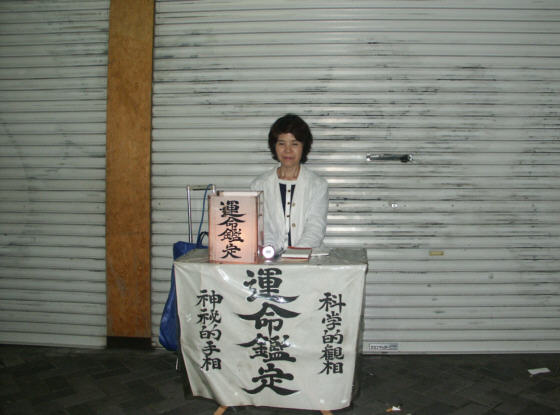
The Japanese tend to be quite a superstitious lot, and on some street corners after the shopshave closed (usually 8 PM) you can sometimes see these older women ready to look at your hands andtell you your "future" -- for a small price of course. You'd be amazed at how many highly educated inJapan have been trained to be completely intellectual, yet put full faith in the wildest superstitions you canimagine -- of course, they still think all old western superstitions are just rubbish. Perhaps the biggestold wive's tale Japanese go for, which makes any interest in horoscopes elsewhere look tame, is that yourblood type determines your personality. Japanese doctors laugh their heads off when you mention this tothem, but it's yet another belief in putting form over substance.
Drumming Up Some Business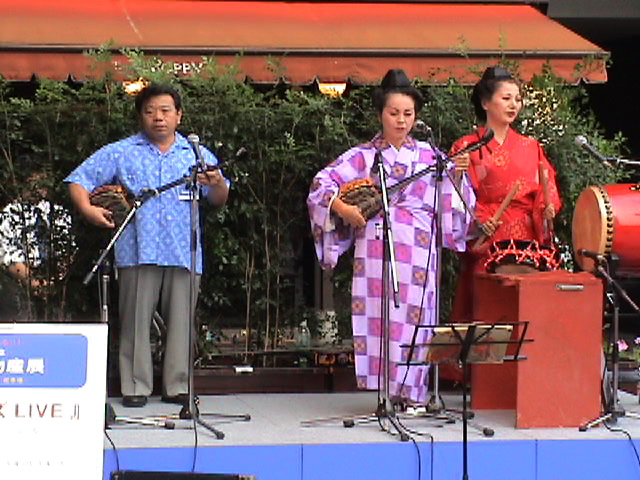
Click here for Quicktime Video
Here is something you don't see wherever you come from -- and don't see much in the rest of Japan either.This was a small concert of Okinawan musicians singing a traditional folk song -- not in Okinawa, but on one of Japan's main islands in front of a department store. The dewey-eyed Japan newcomer might wax poeticabout how deep Japan's culture is; how wonderful they still celebrate their ancient heritage. But the real reasonthey're doing it is to drum up some tourism for Okinawa -- any they can scrape up. Okinawa is one of the poorestregions of Japan, and without tourism the whole place would be doomed. With the Japanese economy still floundering,the impact has been all that much harder. |
|
|
|
|
|
|
|
|
|
|
|
Japanese Road Signs, Lines and Traffic LawROAD SIGNS Many road signs that pose restrictions (one way, do not enter, etc.) will have small signs appended to them (white, with black lettering) limiting the restriction to certain times or types of vehicles.
The most popular is:
JITENSHA WO NOZOKU (帺揮幵傪彍偔) "bicycles excluded"meaning that the restriction doesn't apply to bicycles (not that anyone on abicycle would ever pay attention to a "one way" sign anyway).
Others might include- JIDOUSHA (帺摦幵) "(applies to) cars [and trucks, etc.]"
- 9-17 "applies from 9am until 5pm only"
- 9-17 NOZOKU (俋乕侾俈彍偔) "except from 9am until 5pm"
- NIRINSHA WO NOZOKU (擇椫幰傪彍偔) "two-wheeled vehicles excluded"
- TAKUSHI WO NOZOKU (僞僋僔傪彍偔) "taxi excluded"
- BASU WO NOZOKU (僶僗傪彍偔) "bus excluded"
- TOKU, OOGATA (摿丒戝宆) "trucks and special vehicles only"
- 250cc IJOU WO NOZOKU (俀俆侽們們埲忋傪彍偔) "250cc and above excluded"
...WO NOZOKU (乧傪彍偔) means "exclusion" or "excluding".
Signs: "one way" "one way" 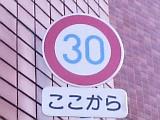 white circle, red ring, blue number inside shows speed limit (in km/h) white circle, red ring, blue number inside shows speed limit (in km/h)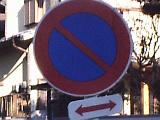 丂"no parking" -- lots of law-breakers here. 丂"no parking" -- lots of law-breakers here.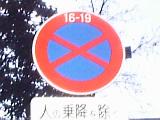 "no parking or stopping" -- even more law-breakers here. "no parking or stopping" -- even more law-breakers here.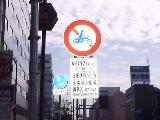 "nobikes over 250cc allowed" (during times specified). Note that this lawis nearly never enforced, or enforced very selectively. "nobikes over 250cc allowed" (during times specified). Note that this lawis nearly never enforced, or enforced very selectively.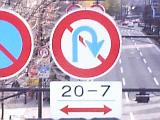 "no U turn", obviously "no U turn", obviously 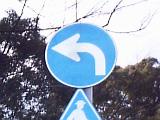 "left turn only" -- i.e. no right turn "left turn only" -- i.e. no right turn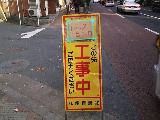 "Under Construction" "Under Construction"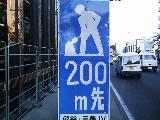 "Construction ahead" -- Here, 200m ahead "Construction ahead" -- Here, 200m ahead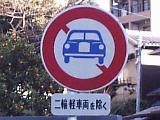 "No Cars may enter (but bikes OK)" --often in packed neighborhoods or small mountain roads "No Cars may enter (but bikes OK)" --often in packed neighborhoods or small mountain roads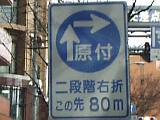 "50cc scooters must dismount for right turn" "50cc scooters must dismount for right turn"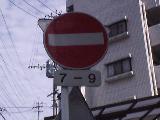 "Do Not Enter" -- On some signs, like in this picture, it only appliesduring the hours listed (often during rush hour, etc.) "Do Not Enter" -- On some signs, like in this picture, it only appliesduring the hours listed (often during rush hour, etc.)  blue or green signs with lettering -- route info, major highways, exit signs, etc. blue or green signs with lettering -- route info, major highways, exit signs, etc.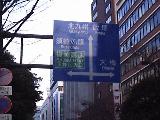 丂Largeblue signs show place names and directions. Often they are 200m infront of an intersection, and are nearly the only signs with the placeslisted in the alphabet. 丂Largeblue signs show place names and directions. Often they are 200m infront of an intersection, and are nearly the only signs with the placeslisted in the alphabet. 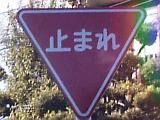 丂 TOMARE (巭傑傟)--"Stop" 丂 TOMARE (巭傑傟)--"Stop"
|
|
|
|
|
|
|
|
|
|
|
|
Note that TOMARE (偲傑傟) will usually be written on the road as well.
Other Signs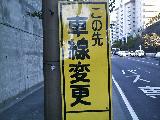 SHASEN HENKOU "must change lane" (due to construction, etc). SHASEN HENKOU "must change lane" (due to construction, etc).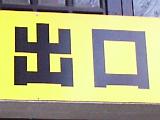 DEGUCHI (弌岥) exit; off-ramp DEGUCHI (弌岥) exit; off-ramp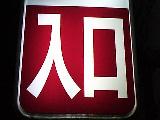 IRIGUCHI (擖岥) enterance; on-ramp IRIGUCHI (擖岥) enterance; on-ramp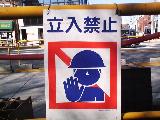 TACHIIRI KINSHI (棫擖嬛巭) "do not enter" TACHIIRI KINSHI (棫擖嬛巭) "do not enter"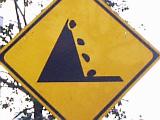 RAKUSEKI CHUUI (棊愇拲堄) "beware of falling rocks" RAKUSEKI CHUUI (棊愇拲堄) "beware of falling rocks"- NIRIN KINSHI (擇椫嬛巭) "no motorcycles allowed"
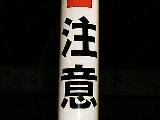 CHUUI (拲堄) 丂"caution" CHUUI (拲堄) 丂"caution"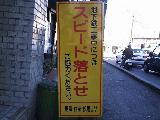 SUPEEDO丂OTOSE (僗僺乕僪棊偣) "slow down" (usually ignored) SUPEEDO丂OTOSE (僗僺乕僪棊偣) "slow down" (usually ignored)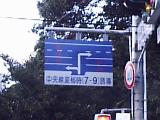 "Lane directions change during hours specified" -- During rush hour a 2by 2 lane road may change to a 3 by 1 lane road to accomodate moretraffic. "Lane directions change during hours specified" -- During rush hour a 2by 2 lane road may change to a 3 by 1 lane road to accomodate moretraffic. 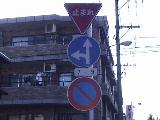 Often signs are put together. Often signs are put together.
For a good collection of other Japan photos for living in Japan, trying visiting
 Road mirrors -- You'll often see mirrors like this along curving roads and blind intersections -- Use them! Many times they're the onlything that keeps some maniac from plowing right into you. Road mirrors -- You'll often see mirrors like this along curving roads and blind intersections -- Use them! Many times they're the onlything that keeps some maniac from plowing right into you.

ROAD LINESContributed by Warren Daniel: I recently asked a couple of police officers (in detail) about the situation regarding lines. According to what they told me, it is safe to cross all white-lines, however, it is prohibited from crossing any yellow-lines. One may *pass* inside of the lane marked with a yellow-line and as long as one does not cross the line, one will be fine. Here's the breakdown of what they gave me:
White lines/yellow lines:
1) Broken white-line -- go for it. Just use your turn signal and no one really cares.
2) Solid white-line --- go for it but use caution. The purpose of the solid, white-line is to highlight the fact that changing lanes is more dangerous but one may cross the line.
3) Solid yellow-line -- do not cross. Passing within the lane is okay and also cutting across the line due to double-parked cars is fine.
About solid yellow lines, Tetsuya Nishimura contributes:
It becomes Oikoshi Kinshi (捛偄墇偟嬛巭 - No Passing) only whenaccompanied by a no-passing sign. And the no-passing sign is thesame as Oikoshi No Tame No Hamidashi Kinshi (捛偄墇偟偺堊偺偼怘傒弌偡嬛巭 - No crossing of line when passing): a white sign with ared circle and slash with two arrows inside), which peoplegenerally believe no-passing, except a white, recangularsupplimental sign underneath it saying Oikoshi Kinshi (nopassing).
4) Solid, thick yellow-line -- DO NOT CROSS. They seemed to stress that one... It was almost as if crossing the thick, yellow line means "Go straight to jail, do not pass go." This also includes the thick yellow-line which contains a thick
white-line.
Nirinsha (two-wheeled vehicle) zones:
1) white-line leading to the nirinsha zone -- may be crossed to reach the nirinsha zone.
2) yellow-line leading to the nirinsha zone -- may be crossed to reach the nirinsha zone *if* cars are not moving. If cars are moving, however, it is not to be crossed.
3) white-line that turns into a yellow-line leading to thenirinsha zone -- white part may be crossed at anytime however yellowarea may only be crossed when cars are not in motion. Same as number 2above.
4) confusing, what-the-hell-does-this-mean, speckledwhite-yellow-white-yellow-line -- I personally feel that it is anattempt at the sanity of motorcyclists by the police but from what Iwas told, if a line hasany amount of yellow in it, treat it as if it is a yellow line. When Iasked if it was permittedto wheelie down while avoiding the yellow areas, they just laughed. Ihave no idea why. ;-)
On the highway:
1) broken white-line (lane lines) -- Again, maybe crossed however turn, however, use of turn signal is needed.Tetsuya Nishimura also contributed: Onmajor National Routes and Expressways, the distance from the beginningof a broken line to the beginning of the next broken line is usually 20meters. It may not be the case in the city even if it's a major route.
------ ------ ------ ------
|<- 20m ->| |<- 20m ->|
2) solid white-line (lane lines) -- Okay to cross but use caution.
3) solid white-line (emergency lanes) -- These are not to becrossed unless stopping in the emergency lane. Although cagers enjoybarreling down the emergency lanes, especially during Golden Week andother times ofmajor backups, you'll get stopped if they see you.
4) yellow-line (where incountered) -- Cannot cross although passing is allowed (???).
Other notes courtesy of Tetsuya Nishimura:
Two white diamonds lined up vertically Pedestrian crossing ahead
White inverted triangle Yield ahead
"60 Kou Chuu" ("60崅拞") 60km/h for high and mid speed vehicles
With this paint on the road, Chuusokusha (Mid-speed vehicle)that includes 125-250cc bikes can run at 60km/h, which exceeds thelegal speed limit for the class on the ordinary street (50km/h) by10km/h. 50 Kou Chuu and 40 Kou Chuu are more frequently seen.[Note: Wherever possible Japanese routinely exceed the speed limitanyway--patrol cars, comparitively speaking, are few and far between.Still, keeping Murphy's Law in mind...]

 A typical city street. A typical city street.
TRAFFIC LAW--TICKETS, PENALTY SYSTEM, ETC. Japanhas a point system (you get "points" for various bad things, andvarious extra penalties kick in when the points reach certain limits).There are two levels of inebriation with respect to driving. One isplain and simple "drunk" (0.05% BAC, I believe). The other I translateas "tipsy", and is apparently a rather subjunctive observation of ifyou've been drinking or not.
In the following list of offenses and their respective point penalties, the second of a pair of numbers is the penalty if you're "tipsy" when you're nabbed. For example, riding w/o proper helmet is a 1 point violation unless the officer notices you've been drinking, at which it becomes a 7-point violation (and, as you'll see, a one-month suspension of your license).
[tr]License suspensions in last 3 years Points for 1 month suspension Points for revocation of 1 year 2 years 3 years[/tr]| none | 6-14 | 15-24 | 25-34 | 35+ | | 1 | 4-9 | 10-19 | 20-29 | 30+ | | 2+ | 2-4 | 5-14 | 15-24 | 25+ |
Points more than three years old disappear. Also, a one-year clean record (no accidents or tickets) clears all points. Note that speeding 30 km/h over the limit results in six points, which is a one-month license suspension. Ouch! [Believe me, I know]
If your license is suspended, you have the option of going to a class (one or two days long, depending upon number of points) to reduce the length of the suspension. At the end of the class, you take a test (they have an English test available) whose most difficult question is something like "true or false: you can drive as wild and rude and crazy as you like, so long as you don't hurt anyone" (answer: false). Depending upon how well you do on the test (I got all answers correct; took three minutes), they reduce your suspension to as little as one day (that one day being the day you take the class, so you can't drive to the test center).
[ Last edited by the_slayers at 25-2-2008 02:06 AM ] |
|
|
|
|
|
|
|
|
|
|
|
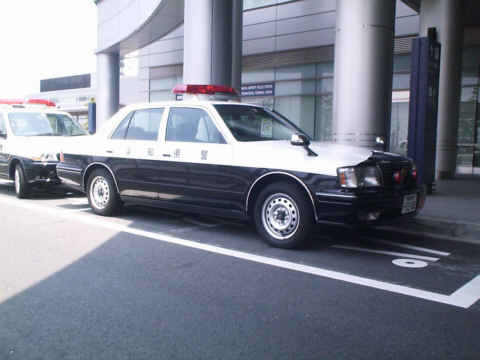
A cop car - best not to do something stupid with one of these behind you...
NOTE: Some pages contain Japanese script--if your computer's OS or browser is not set up to read it, many words will simply look like garbage |
|
|
|
|
|
|
|
|
|
|
|
Konica Minolta Buka Kilang Luar Negara Pertama Di Melaka
MELAKA, 12 Mac (Bernama) -- Konica Minolta dari Jepun, syarikat pakardalam bidang imejan terutamanya bagi kamera dan produk berkaitan akanmembina kilang luar negara pertamanya di Taman Tasik Utama, Ayer Keroh,di sini, bagi mengeluarkan substrat kaca pemacu cakera keras.
Pengarah urusan Konica Minolta Glass Tech (M) Sdn Bhd, KoichiTakikawa, berkata kilang tersebut yang pada awalnya bangunan kilangmerangkap pejabat, dijadual siap sepenuhnya pada Disember dan akanberoperasi pada Januari.
"Bahagian pertama pelaburan kami ialah RM160 juta dan operasipenuh akan membawa jumlah pelaburan kepada RM700 juta," katanya kepadapemberita di upacara pecah tanah kilang tersebut yang dirasmikan olehKetua Menteri Datuk Seri Mohd Ali Rustam.
Takikawa, yang juga pengarah Konica Minolta Opto Inc, berkataselama ini, Konica Minolta Opto mengeluarkan substrak cakera kerashanya di Jepun.
"Bagaimanapun berikutan pertumbuhan kukuh pasaran pemacu keras,kedua-dua kilang kami di Jepun beroperasi pada tahap maksimumnya dankami memutuskan untuk membina kilang ketiga di sini," katanya.
Menurutnya, pasaran bagi pemacu cakera keras dijangka berkembang kira-kira 20 peratus setahun terutamanya di Asia Tenggara.
"Banyak sebenarnya pengeluar pemacu cakera keras telah memindahkanpangkalan pengeluaran mereka ke rantau ini," kata Takikawa sambilmenambah kilang tersebut akan mempunyai sehingga 1,500 pekerja.
Sementara itu, Mohd Ali berkata 52 projek baru untuk Melakadiluluskan tahun lepas oleh Kementerian Perdagangan Antarabangsa danIndustri.
"Kita berjaya menarik pelaburan domestik dan pelaburan langsung asing yang berjumlah RM1.4 bilion," katanya.
Beliau berkata pelaburan baru adalah dalam produk bukan-logam(RM715.71 juta), kimia dan produk kimia (RM144.08 juta), dan kertasserta produk pencetakan (RM108.45 juta).
Baki pelaburan yang diluluskan adalah bagi 30 projek pengembangan.
Mohd Ali berkata Melaka menjadi pilihan utama bagisyarikat-syarikat utama dari Jepun untuk membuka kilang luar negaramereka di sini. Antaranya termasuklah Panasonic, Honda Motors dan TEAC |
|
|
|
|
|
|
|
|
|
|
|
Honda catat kenaikan tujuh peratus jualan 2007
PETALING JAYA 1 Feb. - Honda Malaysia Sdn. Bhd. mencatat rekodjualan tertinggi bagi segmen kereta penumpangnya pada tahun lalu iaitusebanyak 28,479 unit, meningkat sebanyak tujuh peratus berbanding tahun2006.
Pengarah Urusan dan Ketua Pegawai Eksekutifnya, Atsushi Fujimotoberkata, prestasi positif itu dicapai di sebalik penurunan 0.7 peratusjumlah keseluruhan industri (TIV) yang dilaporkan oleh PersatuanAutomotif Malaysia (MAA), baru-baru ini.
Menurutnya, bukan saja jumlah jualan Honda mengatasi sasaran asalbagi tahun 2007 sebanyak 28,000 buah, ia juga mengukuhkan penguasaanpasaran Honda dalam segmen kereta bukan nasional kepada 5.8 peratus.
''Prestasi baik yang dicatat Honda ini didorong oleh jualan larisCR-V, generasi kelapan Civic dan City yang dipertingkatkan yangkesemuanya menepati sasaran masing-masing bagi tahun 2007," katanyadalam kenyataan di sini hari ini.
Tiga model terlaris itu adalah sebahagian daripada lapan model Hondayang dijual di Malaysia termasuk varian istimewa Accord VTi-S, CivicType Rdan Hybrid, Jazz dan Stream.
Pada tahun ini, Fujimoto berkata, Honda meletakkan sasaran jualankenderaannya dari 28,000 tahun lalu kepada 33,000 buah untuk meraihpenguasaan pasaran 6.5 peratus serta terus menerajui indeks kepuasanpelanggan.
Menurutnya, Honda akan melancarkan beberapa model baru pada tahunini, bermula dengan generasi kelapan Honda Accord yang dijangka padaseparuh pertama tahun ini.
Dari aspek pengeluaran, Fujimoto berkata, Honda juga mencatatkeluaran kenderaan yang ke-100,000 di kilang pemasangannya di Pegoh,Melaka, hanya dalam tempoh lima tahun ia beroperasi.
Tahun lalu juga, katanya, kilang Pegoh mencatat pengeluaran set yangke sejuta bagi Constant Velocity Joint (CVJ), menandakan keupayaannyamenyediakan komponen kenderaan yang mencapai piawaian eksport danberkualiti.
''Bagi memenuhi permintaan pasaran yang semakin tinggi, kilang Pegohakan ditambah kapasiti pengeluarannya dari 25,000 kenderaan setahunkepada 30,000 setahun," katanya.
Beliau berkata, dari segi tanggungjawab sosiol, Honda terus memenuhikomitmennya kepada Projek Menyelamatkan Badak Sumbu menerusi TabungHidupan Liar Dunia (WWF) yang memasuki tahun kedua.
''Program itu bermatlamat mendedahkan pengetahuan dan mendidikgenerasi muda mengenai isu pemuliharaan alam sekitar menerusi programlawatan ke sekolah-sekolah dan ceramah awam," katanya.
Di samping itu, kata Fujimoto, dalam program Dana Impian Honda pula,20 remaja menerima biasiswa khas Honda bagi membantu mereka mencapaiimpian dan memenuhi potensi mereka di masa depan.
 |
|
|
|
|
|
|
|
|
|
|
|
Konica Minolta sasar keluar 3 juta kaca lensa sebulan
MELAKA 22 Feb. - Konica Minolta Glass Sdn. Bhd., pengeluar kepingankaca untuk kegunaan lensa kamera dari Jepun, mensasarkan pengeluaransebanyak 3 juta keping kaca sebulan.
Kilang pengeluaran kaca lensa pertama milik Konica Minolta Opto diluar Jepun yang terletak di kawasan perindustrian Tasik Utama, AyerKeroh itu telah memulakan pengeluarannya sejak bulan lalu.
Presiden Konica Minolta Opto Inc., Takashi Matsumaru berkata, kilangtersebut kini telah berjaya mengeluarkan sebanyak sejuta keping kacasebulan dan akan mempertingkatkannya dari masa ke semasa.
''Pada masa kini kami telah mengeluarkan sejuta kepingan kaca padaJanuari lalu dan kami menjangkakan ia dapat dipertingkatkan menjelangMei tahun ini apabila mesin baru diperoleh.
''Dengan mesin baru ini, kilang kami di sini mampu menghasilkan sehingga 3 juta kepingan kaca sebulan," katanya.
Beliau berkata demikian ketika berucap pada majlis perasmianpembukaan kilang Konica Minolta Glass oleh Ketua Menteri, Datuk SeriMohd. Ali Rustam di sini, petang semalam.
Turut hadir, Pengarah Urusan Konica Minolta Glass Malaysia, KouiciTakikawa serta Pengerusi Jawatankuasa Perindustrian, Perdagangan,Pembangunan Usahawan dan Koperasi negeri, Datuk Wira Ahmad Hamzah.
Matsumaru berkata, kilang pengeluaran kaca tersebut mula dibina padaMac tahun lalu dan pada April lalu, kilang tersebut beroperasi dengantiga orang kakitangan.
''Tetapi sehingga kini jumlah tersebut telah mencapai 275 orang," kata beliau. |
|
|
|
|
|
|
|
|
|
|
|
Originally posted by the_slayers at 25-2-2008 01:21 AM 
lonely planer ker lonely planner atau lonely planet?sape pengarang buku tu juju?
ko beli yg ak bold nih..lonely planet..ak pun dh tertypo salah...ahakss.. |
|
|
|
|
|
|
|
|
|
|
|
ko buat aper nk tau info pasal jepun ...ko nk smbg study kt jepun eh... |
|
|
|
|
|
|
|
|
|
|
|
sabtu ahad ni kinolta minolta wat open interview sapa nk g ngn dee  |
|
|
|
|
|
|
|
|
|
|
|
huh...panjangnyer nak baca.. |
|
|
|
|
|
|
|
|
|
|
|
Reply #33 juju_amin84's post
tak ahh...keje kat kilang jepun  |
|
|
|
|
|
|
|
|
|
|
|
Reply #35 lissa's post
sebenarnya banyak lagi info nak tepek
tapi dah ngantuk masa tu |
|
|
|
|
|
|
|
|
|
|
|
Reply #34 dee_dee's post
open interview?
post aper yang ader ek... |
|
|
|
|
|
|
|
|
|
| |
Category: Negeri & Negara
|